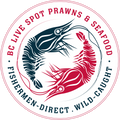It is a new year.
A clean slate.
A healthier you.
Healthy eating does not need to be a chore or something that you dread doing. It is a lifestyle change that you can begin to implement in subtle ways. An easy way to begin this is by looking at your pantry.
Our pantries seem to get the bad rap that they are gateway snack zones, filled with easy and sometimes unhealthy choices. Generally agreed upon, wild seafood is considered one of the healthiest proteins and omega-3 sources available to us. With no argument there, the idea of cooking those delicious superfoods can become overwhelming.
With some classic staple ingredients in your pantry, you will find yourself reaching for healthy, homemade meals in no time.
What Are Staple Ingredients?
Flash-frozen seafood, such as wild tuna, BC spot prawns, and Dungeness crab, are all packed full of nutrients our bodies crave. Getting to know your local fishermen not only guarantees quality fresh products, but it also is fishermen-direct and 100% traceable. Purchasing a quality product will ensure a fresh dish.
Fresh seafood, like many fresh ingredients, have limited shelf-lives. This is where your staple ingredients help you stress less and cook more! Similar to the basic principle of flour and water can make pasta, but add an egg and sugar...now you have a cake.
Whole Grains
Benefits of whole grains date back thousands of years, and continue to show protective properties against certain diseases, cancer, diabetes and obesity. Packed with rich nutrients like fiber, vitamin E, copper, magnesium, selenium, zinc, and B vitamins, in addition to helpful disease preventative compounds, whole grains are not only healthy but shelf-stable. Whole grains have also shown to beneficially impact chronic inflammation.
Incorporating whole grains into your healthy lifestyle can be done in a variety of ways. Taking a closer look at food labels will help you make better informed decisions. To be considered truly “whole” grain, the word “whole” must be present. “Wheat” is a health catch word because it is not the same as “whole wheat”. Whole grains, such as sorghum, bulgur, and quinoa may not be as familiar to you as others (barley, wild rice, buckwheat), but this should not stop you from trying them.
Healthy Fats
When discussing healthy fats used in cooking, it can be hard to get past the word itself. Healthy fats used in cooking include, but not limited to, olive oils, canola oil, peanut oil, and sunflower oil. Depending on the cooking fat used, the product’s shelf life will vary, but most oils tend to have longer shelf lives.
Cooking with fats involved more than helping your seafood not stick to the pan. Salad dressings, marinades, and sauces all contain a mixture of oils and fats. Making your dressings and sauces are healthy tips to learn.
Healthy cooking fats are used as substitutes for some less healthy cooking fats (butter and other solid fats). A little can go a long way with oils. Drizzle and taste, drizzle and taste will strengthen your chef pallet and help you avoid over drizzling your dish.
Cooking oils are similar to seafood. If it smells bad, do not use it. Oxidation will occur when the oil is stored for too long, at this point the oil is rancid. If your oil reaches its smoking point and begins to smoke, the oil has already begun to degrade, and you should start the oil over. Entering the culinary world of oils and cooking fats will continue to surprise you with opportunity.
Basic Pantry: tarragon, parsley, chives, and dill
The basics in your pantry should include flour, seasonings, and dried herbs. Flour is a cooking/baking essential. From seafood to birthday cakes, flour has many purposes, and is offered in many varieties to fit personal needs.
Similar to the options of flour, seasonings and dried herbs are based on personal preference when it comes to the dish and taste. Common ones include tarragon, parsley, chives, and dill.
Tarragon
Tarragon, in both mild and strong types, requires less than more! No matter the type of tarragon used, the flavors can quickly become powerfully intense. If you already have tarragon in your pantry, chances are you have the French or Russian type. Both warm and cooling, similar to the taste of licorice, French tarragon is sweet and mild. Russian tarragon offers a stronger flavor that can hold up to more pungent ingredients.
Parsley and Chives
Offering an earthy, hint of peppery taste, parsley can be a fresh garnish, added to a sauce, and blended for other culinary purposes. Chives are also great garnishes that give your seafood dish a pop of color and taste. With the ability to pair harmoniously with other herbs, chives taste similar to an onion/garlic cross.
Dill
Dill has been claimed to be the best herb to pair with seafood. Light and delicate, dill enhances the taste and flavors already naturally present in seafood. One of the main reasons fresh seafood is enjoyed around the world is because of the unique and identifiable flavors found in seafood. Dill gives you limitless options when it comes to garnish and use.
The takeaway...to your kitchen!
Seafood should not be daunting to cook. When you have staple ingredients in your pantry, your main focus can be on selecting and ordering your high-quality seafood. There is no right or wrong way to build your staple ingredients. Personal health considerations will be the driving factor behind what you choose as your staple ingredients. Once those are on hand, keeping the items stocked becomes second nature.
Bring your culinary seafood favorites to whole new levels!





Leave a comment